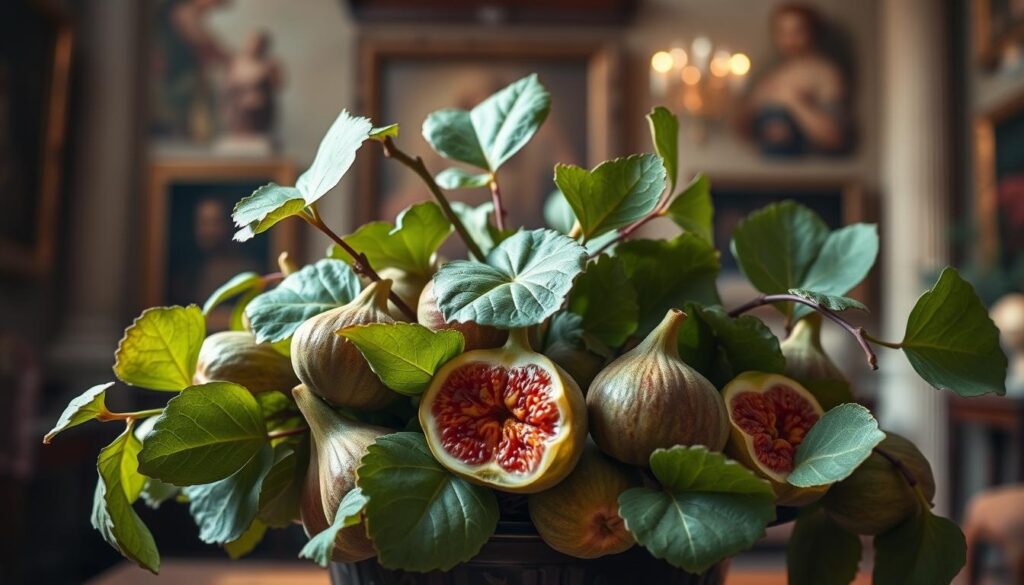Imagine standing at the dawn of human civilization. A simple fig leaf became the world’s first fashion statement. The history of fig leaf clothing goes back to ancient Mesopotamian civilizations.
Our ancestors found fig leaves to be more than just plant material. They were a practical solution for covering and protecting the body. The ancient fashion trends of using fig leaves as clothing emerged from necessity.
Mesopotamian cultures saw the unique properties of fig leaves. They were large, thick, and easy to find. This made them perfect for creating basic coverings.
Archaeological evidence shows that these leaves were more than a temporary fix. They were the first steps toward understanding textiles and personal protection.
The history of fig leaf clothing shows a deep connection between humans and nature. Fig trees were common in early civilizations, providing food and material for the first clothes. This shows how resourceful our ancestors were in using nature’s gifts.
Exploring where fig leaves came into fashion, we find a story of human innovation. It’s a tale of survival, adaptation, and the start of personal expression through clothing.
Table of Contents
Introduction to Fig Leaves in Fashion
Fig leaves have become a symbol in culture and fashion. They have a rich history, from biblical stories to art. These leaves tell a story of symbolism and meaning.

The story of fig leaves in fashion is filled with deep meaning. Biblical references show them as the first clothes, symbolizing modesty and change.
The Symbolism of Fig Leaves
Fig leaves mean different things in various cultures:
- They stand for innocence and vulnerability.
- They symbolize human dignity and the need to protect ourselves.
- They are a metaphor for hiding and keeping safe.
Historical Context of Fig Leaves
Fig leaves were used as clothes in ancient times. They meant more than just covering up. They carried deep social and spiritual messages.
*”In the intricate tapestry of human expression, fig leaves represent more than mere fabric – they are a language of cultural communication.”*
| Cultural Context | Symbolic Meaning |
|---|---|
| Biblical Tradition | First clothing, symbol of human awareness |
| Artistic Representation | Metaphor for modesty and transformation |
| Philosophical Discourse | Emblem of human vulnerability |
Fig leaves in fashion still inspire today. They connect old traditions with new designs.
The Origins of Fig Leaves in Clothing
Ancient people found clever ways to use natural materials for clothes. Fig leaves were a key discovery for covering up. The use of fig leaves shows how humans needed to use what nature gave them.

Fig leaf clothing has a rich history across many cultures. It shows how ancient people were creative with their clothes. Archaeologists have found clues about how these early garments were made.
Ancient Civilizations and Fig Leaves
Early societies saw the value of fig leaves for clothes. These leaves were big, easy to find, and lasted long. They were perfect for making clothes.
- Naturally large leaf size providing excellent coverage
- Widespread availability in Mediterranean and Middle Eastern regions
- Durability compared to other plant materials
- Adaptability for various clothing purposes
Fig Leaves in Ancient Greece and Rome
In ancient Greece and Rome, fig leaves were more than just clothes. They stood for modesty, creativity, and stories of their time.
Fig leaves were more than just clothes—they showed human creativity and how we adapt to nature.
| Civilization | Fig Leaf Usage | Cultural Significance |
|---|---|---|
| Mesopotamia | Early protective garments | Practical survival technique |
| Egypt | Artistic representations | Symbolic cultural element |
| Greece | Sculptural coverage | Aesthetic and moral symbol |
| Rome | Artistic and practical use | Complex social metaphor |
Ancient fashion trends show how people were creative with fig leaf clothes. It shows how humans can turn nature into useful and meaningful clothes.
The Role of Fig Leaves in Art
The Renaissance changed art, especially how people were shown. Fig leaf garments in art helped artists tell stories of society and religion.

Artists found creative ways to show modesty and avoid nudity. They used fig leaves to balance art and cultural rules.
Renaissance Artistic Transformations
In the Renaissance, artists started to censor their work. They used fig leaves to show moral values. This was a way to meet cultural standards.
- Michelangelo’s sculptures often featured carefully placed fig leaves
- Religious institutions drove the aesthetic modifications
- Fig leaves represented moral guardianship in artistic representations
Notable Artists and Their Techniques
“The fig leaf became more than a botanical element – it was a statement of cultural propriety.” – Art Historian
Artists like Masaccio and Raphael used fig leaves in their work. They turned them into symbols of social norms.
| Artist | Artwork | Fig Leaf Significance |
|---|---|---|
| Michelangelo | David Sculpture | Modesty overlay |
| Masaccio | Expulsion from Eden | Biblical symbolism |
| Raphael | Various Paintings | Cultural censorship |
The fig leaf’s journey in art shows a deep story of cultural change. It connects art and society’s views.
Fig Leaves in Literature
Literature has long used fig leaves as symbols, turning them into deep metaphors. The biblical references to fig leaves have shaped many stories, showing themes of modesty, vulnerability, and human nature.

Fig leaves in clothing mean more than just covering up. Writers often use them to symbolize:
- Concealment of human vulnerability
- Representation of shame and innocence
- Metaphorical protection against social judgment
Symbolism in Classical Literature
Classical literature often used fig leaves to explore the human condition. The symbolism of fig leaves in fashion became a way for authors to delve into complex emotions. They used this simple image to reveal deep truths.
“Like a fig leaf covering the raw truth of human existence, literature reveals what it simultaneously conceals.”
Contemporary References to Fig Leaves
Today’s writers still find inspiration in fig leaves. They use these symbols to explore personal truth and societal pressures. Fig leaves help them show the human side of stories.
From ancient tales to modern stories, fig leaves continue to hold a special place. They remind us of our shared experiences of vulnerability and the need to hide and reveal.
Modern Fashion: The Resurgence of Fig Leaves
The fig leaf fashion evolution is exciting in today’s designs. Designers are giving this ancient symbol a new life. They turn it from a symbol of modesty to a modern fashion statement. The symbolism of fig leaves still fascinates many in the fashion world.

Today’s fashion houses are finding new ways to use fig leaf designs. They show up in many interesting ways:
- Textile prints that look like fig leaves
- Clothes made from sustainable materials inspired by leaves
- Accessories with abstract fig leaf designs
- Unique runway pieces that celebrate nature
High Fashion’s Leafy Transformation
Luxury designers love the story of fig leaves in fashion. They create intricate patterns and shapes that honor the leaf’s history. They use new ways to work with fabrics, showing respect for the leaf’s past.
| Design Category | Fig Leaf Inspiration | Key Characteristics |
|---|---|---|
| Haute Couture | Organic Silhouettes | Flowing, nature-inspired cuts |
| Streetwear | Graphic Leaf Prints | Bold, stylized leaf motifs |
| Accessories | Leaf-Shaped Jewelry | Delicate, nature-inspired pieces |
Streetwear’s Natural Revolution
Urban fashion designers are using fig leaves in new ways. They put leaf outlines on graphic tees and use sustainable fabrics. Streetwear shows that fig leaves are more than just history.
“Fashion is nature’s most beautiful conversation” – Contemporary Design Philosopher
Eco-Friendly Fashion and Fig Leaves
The journey of fig leaf fashion evolution inspires us today. It shows how ancient uses of fig leaves as clothing connect us to the environment. This journey links our love for nature with our fashion choices.

Now, designers are looking at fig leaves again. They see them as a natural material for eco-friendly clothes. The history of fig leaf clothing shows us how it’s been used in many ways, always caring for the planet.
Sustainable Practices in Modern Clothing
Today, designers are using fig leaves in new ways. They focus on sustainable fashion with several key steps:
- Using biodegradable natural materials
- Minimizing textile waste
- Creating organic clothing collections
- Implementing regenerative design principles
Fig Leaves as a Natural Material
Fig leaves are more than just history. Modern sustainable fashion brands are finding ways to use them in clothes.
| Design Approach | Sustainability Impact |
|---|---|
| Textile Extraction | Low environmental footprint |
| Natural Pigmentation | Reduced chemical processing |
| Biodegradable Properties | Zero waste potential |
“In fashion, nature remains our most sophisticated designer.” – Eco-Fashion Innovator
The study of fig leaf fashion evolution is exciting. It shows how old ideas meet new sustainable designs. This mix of past and present inspires us to create a greener future.
Fig Leaves and Cultural Significance
Fig leaves in clothing mean more than just fabric. They are deeply rooted in human traditions. They symbolize modesty and spiritual enlightenment.

Fig leaves connect nature and human expression. They go beyond clothes, telling stories of cultures worldwide.
Mediterranean Traditions
In Mediterranean cultures, fig leaves hold deep meaning. Ancient Greeks saw fig trees as linked to Dionysus, symbolizing joy and plenty. This made fig leaves important in both practical and spiritual ways.
- Symbolized provision and fertility
- Used in religious and artistic representations
- Represented connection between humans and nature
Global Cultural Interpretations
Every culture sees fig leaves differently. In Eastern philosophies, fig trees stand for wisdom and enlightenment. The Bodhi tree, a fig species, is where Buddha found enlightenment.
| Culture | Fig Leaf Significance |
|---|---|
| Ancient Egypt | Associated with Hathor, representing motherhood |
| Biblical Context | Symbol of modesty and divine judgment |
| Eastern Traditions | Representation of spiritual enlightenment |
“The fig leaf is more than a covering; it’s a cultural artifact that speaks volumes about human creativity and symbolism.”
Ancient fashion trends show fig leaves were more than basic clothes. They were a way to express cultural identity and our bond with nature.
Conclusion: The Evolution of Fig Leaves in Fashion
The fig leaf fashion evolution is more than a trend. It’s a deep cultural story that spans human history. From ancient times to today’s runways, fig leaves symbolize change and creativity.
Fig leaves’ journey into fashion shows the mix of nature, modesty, and art. They went from simple plants to powerful symbols of human creativity and change. Today, designers keep finding new ways to use this timeless idea in modern fashion.
Future Trends and Fig Leaves
Fig leaves might become key in sustainable fashion soon. Designers are looking to use natural materials in new ways. This blend of old and new keeps fig leaves exciting in fashion’s future.
Lasting Impact on Fashion and Culture
Fig leaves show how fashion reflects our culture. They stand for vulnerability, protection, and creativity. Fig leaves are more than fabric; they tell stories that link the past to today’s dreams.







